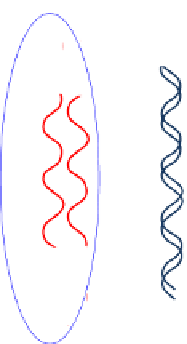Biomedical Engineering Reference
In-Depth Information
express wholly different biochemical capabilities (e.g. the ability to degrade an antibiotic or
detoxify a hazardous chemical in their environment) literally overnight. These alterations
cannot be explained through inheritance and small evolutionary changes in the chromosome.
Rather, they arise from gene transfer from one organism to another and/or large rearrange-
ments in chromosomal DNA. In this section, we will discuss genetic recombination, gene
transfers, and genetic rearrangements
d
all mechanisms that can be exploited to genetically
engineer cells.
14.3.1. Genetic Recombination
Genetic recombination
is a process that brings genetic elements from two different
genomes into one unit, resulting in new genotypes in the absence of mutations. Genetic
recombination can occur naturally in the absence of human intervention. Genetic recom-
bination in prokaryotes is a rare event but sufficiently frequent to be important industri-
ally and ecologically. The three main mechanisms for gene transfer are
transformation,
transduction, and conjugation
.TransformationisaprocessinwhichfreeDNAistakenup
by a cell. Transduction is a process in which DNA is transferred by a bacteriophage,
and conjugation is DNA transfer between intact cells that are in direct contact with one
another.
Once
donor
DNA enters inside a cell, the mechanism for recombination is essentially inde-
pendent of how the donor DNA entered.
Fig. 14.3
summarizes the molecular-level events in
general recombination. The donor DNA must be homologous, or nearly so, to a segment of
DNA on the recipient DNA. Under the right conditions, cellular enzymes cut out the homol-
ogous section of recipient DNA, allow insertion of the donor DNA, and then ligate or join the
ends of the donor DNA to the recipient DNA. Pieces of donor DNA that a cell recognizes as
foreign are usually degraded by enzymes called
restriction endonucleases
(these enzymes are
inte
g
ration
Donor DNA:
Transforming
fragment
Incorporation of
transforming fragment
Transforming DNA
becomes single stranded
One strand of the donor DNA is integrated,
the other is broken and discarded
Recipient cell
FIGURE 14.3
Integration of transforming DNA into a recipient cell.










































Search WWH ::

Custom Search